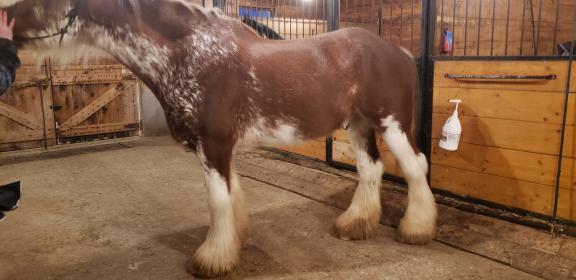Hey there,
My Clydesdale gelding is the first horse I’ve ever owned. I’ve owned him for about 3 years now. He’s in his 10th year. He’s a full clyde standing at 17.2hh. Through horse ownership, I have learned that owning a horse and riding horses truly are two separate hobbies, but I’m determined to do right by this horse. Sorry if this post is long, just trying to provide the important details for you wise horse folk to help me out with.
Last year around mid-summer I had to move him from the place where he was kept for about 4 years to a privately owned farm. In about 2 months I saw him drop from his normal healthy weight to a weight that was just too light. Long story short, I saw so many red flags that I knew I couldn’t trust the farm owners, and therefore I couldn’t keep him there. I moved him to a friend’s farm for a few months (sort of an emergency maneuver) until I found the right facility, which I finally found in December.
Looking back I feel like a fool for not measuring his weight and keeping tabs on the hard data. I was always told that he weighed about 1650-1700lbs. To this day I have never really measured him, just eyeballed his condition. The vet always told us how much dewormer to give him, and he was always healthy looking under the conditions of the first farm I kept him at. In fact, last December before moving him to where we are now I had the vet out for a wellness check and to take a look at his sheath which was swollen at the time (this has since cleared up without issue). When I describe him as skinny it’s not like his hips are showing, but his topline had degraded to the point where it changed the fit of his saddle, and his chest and shoulders seemed less robust. His barrel has some kind of jiggly to it, but I can still feel ribs even today. The Vet told me my horse wasn’t in bad shape, he checked his teeth again, coat and eyes were bright, vitals were fine, wasn’t in poor condition, the fecal count came back and there was only one egg. I had been feeding him U-guard as a precaution and it didn’t seem like he had an issue with ulcers (although we opted not to scope).
So going forward I’m going to do this right. My horse has access to a round bale outside where he is kept, is blanketed, and given about a pound of hi-fat high fiber feed in the morning. In the evening I feed about 2lbs of shredded beet pulp (with molasses), a cup of vegetable oil (which I feel could be increased?) and Black’s Bioplus multivitamin (I think the biotin, selenium and other vitamins and minerals make for an excellent top dressing http://www.horseflowers.com/horsemineral/bioplus.html), 1oz of loose salt (he also has salt licks in the paddock), and I have recently introduced pelleted alfalfa (starting with a 2lb scoop, but ready to increase if needed).
Now I need to know,
Does a regular horse weight tape take an accurate measurement of a draft horse’s weight? If not, how should I go about measuring his weight? I bought a weight tape and it didn’t fit around him!
When I estimate his weight how do I know if I’m feeding way too little? Are any of the quantities standing out to you as being way too little for him? Say he’s anywhere between 1500 and 1700lbs, am I falling drastically short anywhere?
While I’m trying to put weight on him should I be cautious about exercising him? Even if it’s just on the lunge line?
Any other tips?
As I said, I just want to do right by my horse! I don’t have horsey parents, I’m just figuring this out on my own. My feed is inspired by the high fat low starch diets that seem to suit drafts, or so I’ve been reading about. Any more tips or resources would be greatly appreciated.
Thanks kindly in advance

 plus to me it sounds like it could be muscle loss rather than just weight loss
plus to me it sounds like it could be muscle loss rather than just weight loss